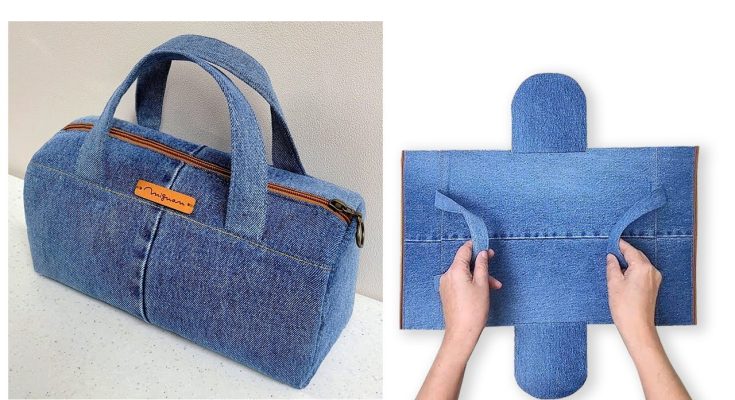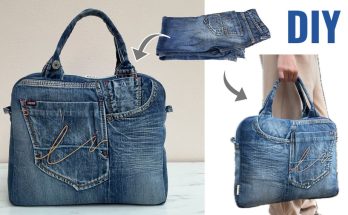Making a special zippered tote bag doesn’t have to be complicated! We can create a stylish and functional tote with a secure zipper, flat bottom, and a neat finish, even if you’re relatively new to sewing. The key is breaking it down into manageable steps and using some clever techniques for a professional look without a lot of fuss.
This guide will focus on creating a medium-sized zippered tote bag with a flat, boxed bottom, an interior slip pocket, and sturdy handles. We’ll use a 1/2-inch (1.27 cm) seam allowance throughout unless specified otherwise.
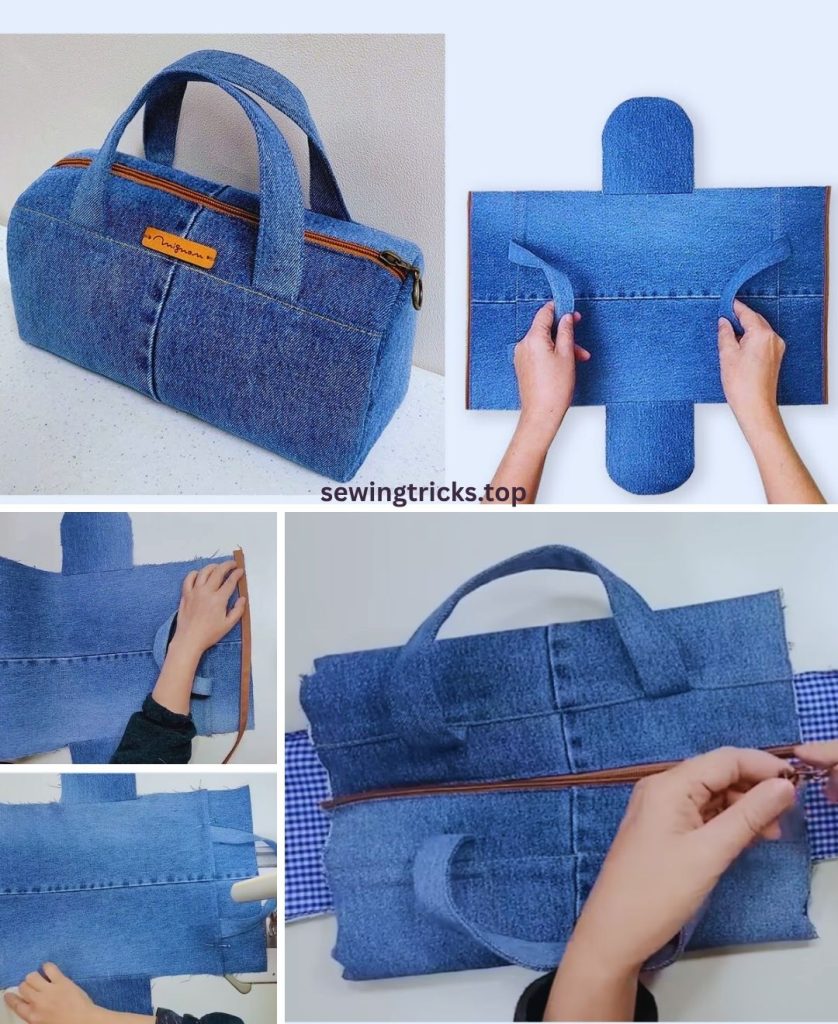
How to Sew a Special Zippered Tote Bag Easily
I. Planning Your Easy Zippered Tote Bag
Even for an “easy” project, a little foresight helps ensure a smooth process and a bag you’ll love.
- Finished Bag Size: A versatile size is approximately 14 inches wide x 15 inches tall x 4 inches deep (about 35.5 cm W x 38 cm H x 10 cm D). This is roomy enough for daily essentials, a book, or some light shopping.
- Fabric Choices:
- Exterior Fabric: Choose a medium to heavy-weight fabric that will give your tote some body. Good options include canvas, duck cloth, denim, sturdy home décor fabric, or twill. A fabric with a bit of stiffness will make it easier to sew and result in a nicer shape.
- Lining Fabric: A lighter to medium-weight cotton fabric like quilting cotton, broadcloth, or poly-cotton is ideal for the interior. This is where you can have fun with a contrasting color or a vibrant print!
- Handles: We’ll make fabric handles from your exterior fabric for a cohesive look. Alternatively, you could use cotton webbing for a quicker option.
- Structure (The “Special” Part!): To give your tote a professional, stand-up quality, we’ll use heavyweight fusible interfacing. This is the secret to a non-floppy bag. Pellon 809 Decor Bond is a great choice for a structured but flexible feel.
- Closure: A zipper is key for security and gives the bag a polished finish.
II. Gather Your Materials
Having all your supplies ready before you start sewing will prevent interruptions and make the process more enjoyable.
- Exterior Fabric: 1 yard (0.9 meters)
- Lining Fabric: 1 yard (0.9 meters)
- Heavyweight Fusible Interfacing: 1 yard (0.9 meters)
- Zipper: One 16-inch (40.6 cm) all-purpose or handbag zipper. A nylon coil zipper is generally easier to sew than a metal one. Choose a color that coordinates well with your fabrics.
- Matching Thread: All-purpose polyester thread. If your exterior fabric is denim or canvas, consider using topstitching thread for visible seams for a more professional, durable look.
- Basic Sewing Supplies:
- Sewing Machine: Ensure it’s capable of handling multiple layers.
- Zipper Foot: Absolutely essential for sewing close to the zipper teeth.
- Walking Foot (Highly Recommended): This attachment helps feed multiple layers of fabric evenly, preventing shifting and puckering, especially with thicker materials and interfacing.
- Sharp Fabric Scissors or Rotary Cutter and Mat.
- Long Quilting Ruler or Measuring Tape.
- Fabric Chalk, Frixion Pen, or Mark-B-Gone Pen.
- Plenty of Pins or Fabric Clips (clips are fantastic for zippers and thick fabric layers!).
- Iron and Ironing Board (crucial for fusing interfacing and pressing seams flat).
- Seam Ripper: Your inevitable best friend for any sewing project!
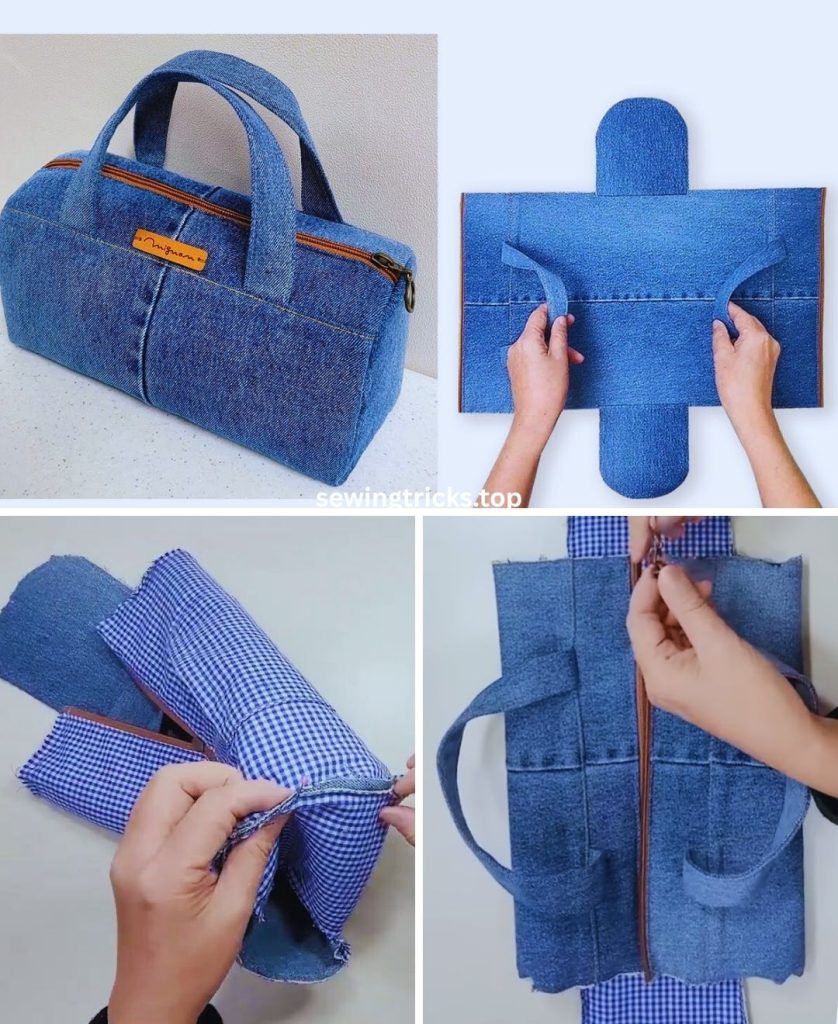
III. Prepare & Cut Your Fabric Pieces
Precise cutting is vital for a well-proportioned bag. Remember, we’re using a 1/2-inch (1.27 cm) seam allowance for all main construction seams.
- Target Finished Tote Size: 14″ W x 15″ H x 4″ D (35.5 cm W x 38 cm H x 10 cm D).
A. Calculate Your Panel Sizes:
- Main Body Panel Width: Finished Width + Finished Depth + (2 * Seam Allowance) = 14″ + 4″ + (2 * 0.5″) = 19 inches (48.3 cm)
- Main Body Panel Height: Finished Height + Finished Depth + (2 * Seam Allowance) = 15″ + 4″ + (2 * 0.5″) = 20 inches (51 cm)
B. Cut Your Fabric Pieces:
- Exterior Fabric Pieces:
- Main Body (Front & Back): Cut 2 rectangles, each 19 inches wide x 20 inches high.
- Handles: Cut 2 rectangles, each 4 inches wide x 25 inches long. (Adjust length for your preferred handle drop).
- Lining Fabric Pieces:
- Main Body (Front & Back): Cut 2 rectangles, each 19 inches wide x 20 inches high.
- Interior Slip Pocket (Optional): Cut 1 rectangle, 8 inches wide x 10 inches high.
- Heavyweight Fusible Interfacing:
- Main Body Panels: Cut 2 rectangles, each 18 inches wide x 19 inches high. (Cut them 1 inch smaller on all sides than your main fabric panels. This keeps bulk out of your seam allowances).
IV. Let’s Start Sewing Your Zippered Tote Bag!
General Sewing Tips for a Clean Finish:
- Press, Press, Press: Don’t skip this! Pressing seams open after each stitching step makes a huge difference in the final look and feel of your bag. Use a hot iron.
- Backstitch: Always secure your stitches by backstitching at the beginning and end of every seam.
- Use Your Walking Foot: If your machine has one, use it, especially when sewing multiple layers or thick fabrics. It ensures even feeding and prevents fabric distortion.
- Fabric Clips: These are fantastic for holding thick layers and zippers in place, often better than pins which can distort fabric.
- Go Slow: Take your time, especially when sewing around corners, attaching the zipper, or going through thick areas. Precision is more important than speed.
- Topstitching: When called for, use a slightly longer stitch length (3.0-3.5mm) for a more pronounced and professional topstitch.
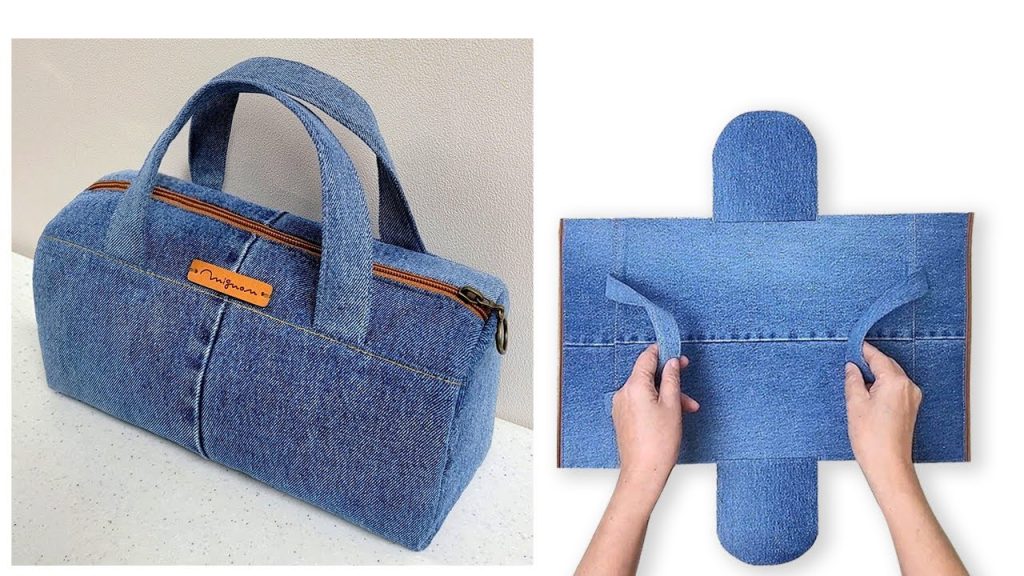
Step 1: Fuse Interfacing to Exterior Panels
- Lay your two Exterior Fabric Main Body Panels wrong side up on your ironing board.
- Center one Interfacing piece on each fabric panel. It should naturally be 1 inch smaller on all sides, ensuring it’s not in your seam allowance.
- Following the manufacturer’s instructions for your specific fusible interfacing, fuse it firmly to the wrong side of the fabric. Apply heat and pressure evenly, then let it cool completely to ensure a strong bond. This is what will give your tote its lovely structure.
Step 2: Prepare Interior Slip Pocket (Optional)
- Take your 8″ x 10″ pocket piece (lining fabric).
- Fold one long 8-inch edge down by 1/2 inch (1.27 cm) towards the wrong side and press. Fold it down again by another 1/2 inch and press. Stitch this double-folded hem in place, sewing close to the inner fold. This will be the neat top edge of your pocket.
- Fold the remaining three raw edges (the two short 10-inch sides and the bottom 8-inch side) in by 1/2 inch (1.27 cm) and press.
- Position this prepared pocket onto the right side of one of your Lining Fabric Main Body Panels. Center it horizontally, and place its top edge about 4-5 inches (10-12.7 cm) down from the top raw edge of the lining panel.
- Topstitch the pocket in place along its two sides and bottom edge, sewing close to the folded edges. Backstitch securely at the beginning and end. For added durability, reinforce the top corners of the pocket opening with a small triangle stitch or extra back-and-forth stitches, as these areas will see stress.
Step 3: Prepare and Attach Fabric Handles
- Take one Handle Piece (4″ x 25″). Fold it in half lengthwise, wrong sides together, and press firmly along the fold.
- Open up the strip. Now, fold each long raw edge in towards the center crease you just made, and press again.
- Fold the entire strip in half again along the original center crease. You should now have a long, flat handle that is about 1 inch (2.5 cm) wide, with all raw edges neatly enclosed. Press firmly along the entire length to set the folds.
- Topstitch down both long sides of the prepared handle, sewing about 1/8 inch (0.3 cm) from each edge. This secures all the folds and creates a neat, strong handle.
- Repeat this entire process for the second handle piece.
- Attach to Exterior Bag Panels:
- Lay one Exterior Fabric Main Body Panel (with interfacing fused) right side up.
- From each side edge, measure in about 4-5 inches (10-12.7 cm) along the top raw edge of the panel. Mark these points with fabric chalk. These marks indicate where your handle ends will be placed.
- Position the raw ends of one prepared handle on the top raw edge of the panel at your marks. Ensure the handle itself is flat and not twisted. The handle should be pointing downwards into the panel. Clip the ends securely in place.
- Stitch the handle ends in place. For maximum strength, sew a small square (about 1×1 inch) with an “X” inside it (an X-box stitch). Perform this stitching within the 1/2-inch (1.27 cm) seam allowance, close to the raw edge. This reinforcement is crucial as the handles will bear the weight of the bag’s contents.
- Repeat for the second exterior panel with the second handle.
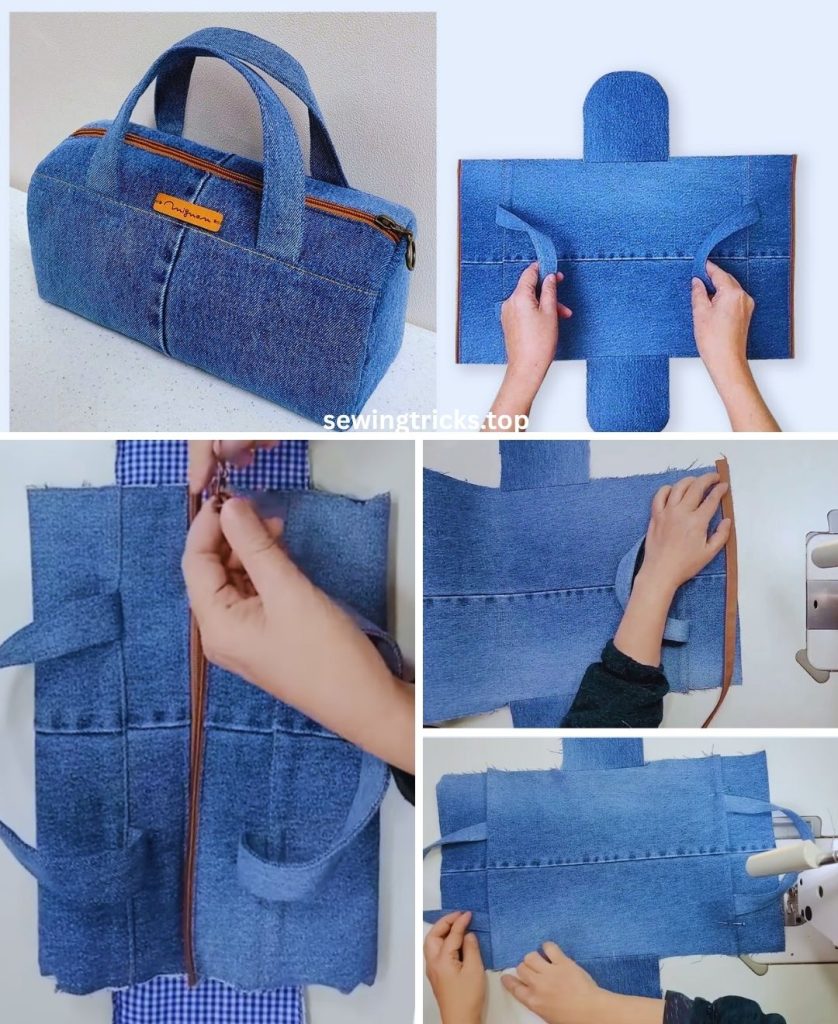
Step 4: Attach the Zipper
This step creates the secure top closure for your tote. Don’t worry, an easy method makes it manageable!
- Lay one Exterior Fabric Main Body Panel (with handle attached, right side up).
- Place your zipper on top of the exterior panel, right side down, aligning the top edge of the zipper tape with the top raw edge of the exterior panel. The zipper teeth should be facing downwards onto the fabric.
- Place one Lining Fabric Main Body Panel on top of the zipper, right side down, aligning its top raw edge with the zipper tape and the exterior panel.
- You now have a “sandwich”: Exterior Fabric (right side up) – Zipper (right side down) – Lining Fabric (right side down).
- Clip all three layers together along the top edge, ensuring the handle is tucked out of the way.
- Using your zipper foot, stitch through all three layers, sewing as close to the zipper teeth as possible. Stitch from one end of the zipper tape to the other.
- Press: Open up the fabric pieces so the exterior and lining are pulled away from the zipper, and the zipper teeth are exposed. Press the fabric well away from the zipper, ensuring the seam lies flat.
- Topstitch: On the right side of the exterior fabric, sew a line of topstitching very close to the seam you just made (about 1/8 inch / 0.3 cm from the zipper teeth). This helps the fabric lay flat and gives a polished look.
- Now, you’ll attach the other side of the zipper.
- Take your remaining Exterior Fabric Main Body Panel (with handle attached). Lay it right side up.
- Take the already-attached zipper/exterior/lining unit. Place it on top of the new exterior panel, aligning the unstitched side of the zipper tape with the top raw edge of this new exterior panel. Ensure the first exterior piece and lining are flipped out of the way.
- Place the remaining Lining Fabric Main Body Panel on top of the zipper tape, right side down, aligning its top raw edge with the zipper tape and the exterior panel.
- You now have a second “sandwich”: New Exterior Fabric (right side up) – Zipper (unstitched side down) – New Lining Fabric (right side down).
- Clip all three layers together along this top edge.
- Using your zipper foot, stitch through all three layers, again sewing as close to the zipper teeth as possible.
- Press & Topstitch: Open up the fabric pieces and press well away from the zipper. Then, topstitch on the right side of the exterior fabric, close to the zipper teeth.
- Result: You now have a flat piece of fabric with the zipper running across the middle. The exterior fabric pieces are on one side, and the lining pieces are on the other. CRUCIAL STEP: Unzip the zipper about halfway or more before proceeding! If you don’t, you won’t be able to turn the entire bag right side out later!
Step 5: Sew the Bag Body (Exterior and Lining)
- Pull the exterior fabric pieces together so they are right sides together. Align the unstitched raw side edges and the unstitched raw bottom edge, forming a “tube.” Clip or pin along these three seams. Make sure the handles are tucked well inside and won’t get caught in the seam.
- Stitch from one side of the zipper down the side, pivot sharply at the bottom corner, stitch straight across the bottom, pivot again, and stitch up the other side to the zipper. Backstitch at the beginning and end of your seam.
- Press all exterior seams open thoroughly to reduce bulk.
- Now, prepare your Lining Fabric Main Body Panels. Pull them together so they are also right sides together. Clip or pin along both side edges.
- For the bottom seam of the lining: This is where we’ll create an opening for turning the bag right side out. Stitch down one side seam. Then, for the bottom seam, stitch approximately 3 inches (7.6 cm) from one side, then leave a 4-6 inch (10-15 cm) unstitched gap in the middle of the bottom seam. This opening is absolutely essential for turning the entire bag right side out. After the gap, stitch for another 3 inches (7.6 cm) to reach the other side seam. Backstitch well at the start and end of your stitching around the gap.
- Stitch up the second side seam of the lining.
- Press all lining seams open.
Step 6: Box the Corners (Exterior and Lining)
This step creates the flat, defined bottom of your tote bag, giving it shape and stability.
- At one of the bottom corners of the exterior fabric bag, carefully bring the side seam and the bottom seam together, aligning them perfectly. This action will naturally form a triangular shape at the corner.
- Measure from the tip of this triangle inward along the seam line a distance equal to half of your desired bag depth (e.g., for a 4-inch deep bag, you’ll measure 2 inches / 5 cm).
- Draw a straight line perpendicular to the seam at this measured point. (This line will be 4 inches long if your desired depth is 4 inches).
- Clip firmly along this drawn line.
- Stitch precisely along the drawn line, backstitching securely at both ends.
- Trim the excess fabric from the corner, leaving about a 1/2-inch (1.27 cm) seam allowance beyond your new stitching line.
- Repeat this exact process for all three remaining corners: the other exterior corner and both lining corners.
- Result: Both your exterior fabric bag and your lining bag now have structured, flat bottoms. Keep the exterior bag right side out and the lining bag wrong side out.
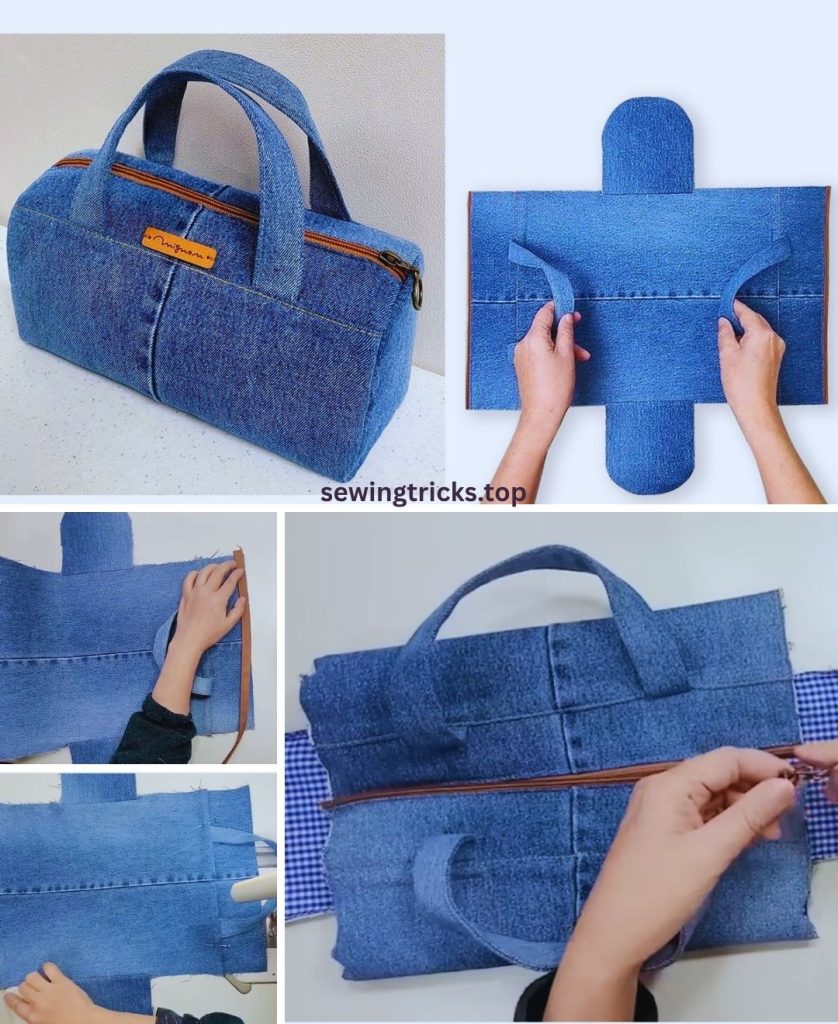
Step 7: Final Assembly (The “Bag-in-a-Bag” Method)
This is a clever technique that encloses all raw edges at the top of your bag, resulting in a very clean and professional finish.
- Carefully insert the exterior fabric bag (which is right side out, with the zipper halfway unzipped, and handles pointing down inside) into the lining bag (which is wrong side out).
- The right sides of both bags should now be facing each other.
- Align the side seams of the exterior bag with the side seams of the lining bag.
- Align the top edges (where the zipper is) of the exterior fabric and the lining fabric all around the entire opening of the bag. The zipper tape will be sandwiched between the two layers.
- Clip very securely all the way around this entire top opening, matching up seams precisely. Make sure the handles are tucked well inside and won’t get caught in the seam.
- Using your 1/2-inch (1.27 cm) seam allowance, stitch all the way around the entire top opening of the bag. Go slowly and carefully, especially over the zipper ends and where the handles are attached (these areas will be thick!). Backstitch at the beginning and end of your seam.
- Trim Bulk: Carefully trim the seam allowance at the top down to about 1/4 inch (0.6 cm) to reduce bulk inside the top edge for a smoother finish.
Step 8: Turn Your Bag Right Side Out & Finish
This is the incredibly satisfying moment your stylish tote bag takes its final, beautiful shape!
- Remember that opening you left in the bottom seam of the lining in Step 5? Reach through it.
- Slowly and carefully pull the entire bag (exterior, zipper, lining – everything!) through this opening until it is completely right side out. Take your time, gently pushing out all the corners and seams for a crisp, well-defined shape.
- Close the Lining Opening: Go to your ironing board. Press the raw edges of the opening in the bottom of the lining under by 1/2 inch (1.27 cm) so they meet neatly. Align these pressed edges and clip them together. Stitch this opening closed by machine (sewing very close to the folded edge for a neat finish) or by hand using an invisible ladder stitch for a truly seamless look.
- Now, gently push the lining down into the exterior bag, ensuring it sits smoothly inside.
- Final Press & Topstitch: Carefully press the entire top edge of the bag, especially around the zipper, to ensure the fabric lays flat and the shape is crisp.
- For a super polished and durable finish, topstitch all around the entire zipper opening, sewing about 1/8 inch (0.3 cm) from the zipper teeth. This final topstitching secures the lining to the exterior, helps the zipper lay flat, and gives your bag a professional, finished look.
Congratulations! Your unique, handmade Stylish Zippered Tote Bag is now complete. You’ve created a functional, durable, and truly personalized accessory that you can use with pride.
What kind of fabric did you choose for your tote’s exterior?
Video Tutorial


